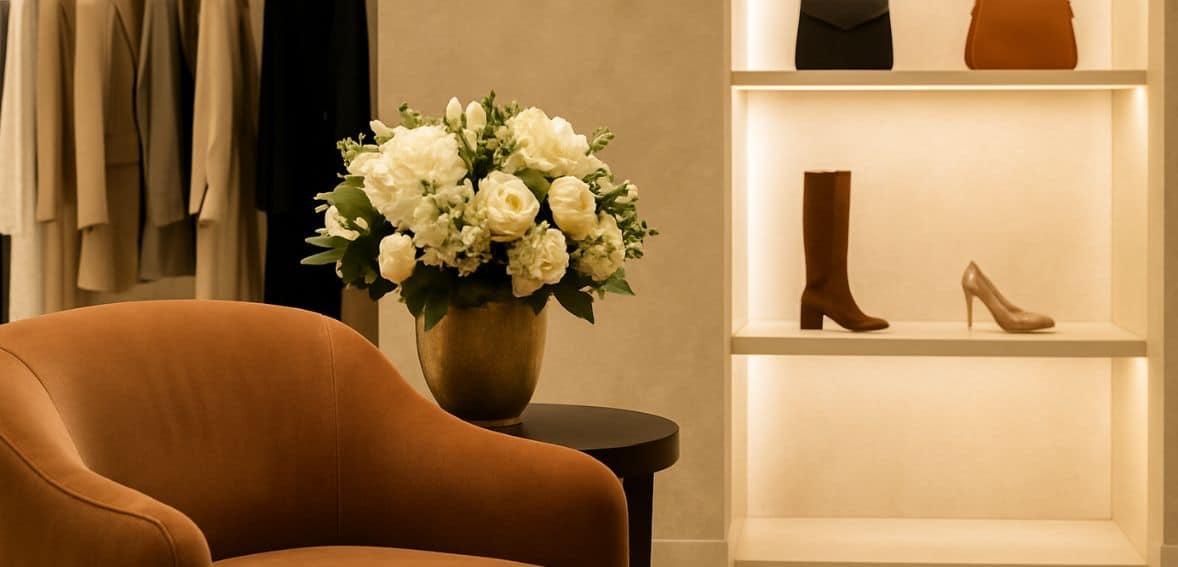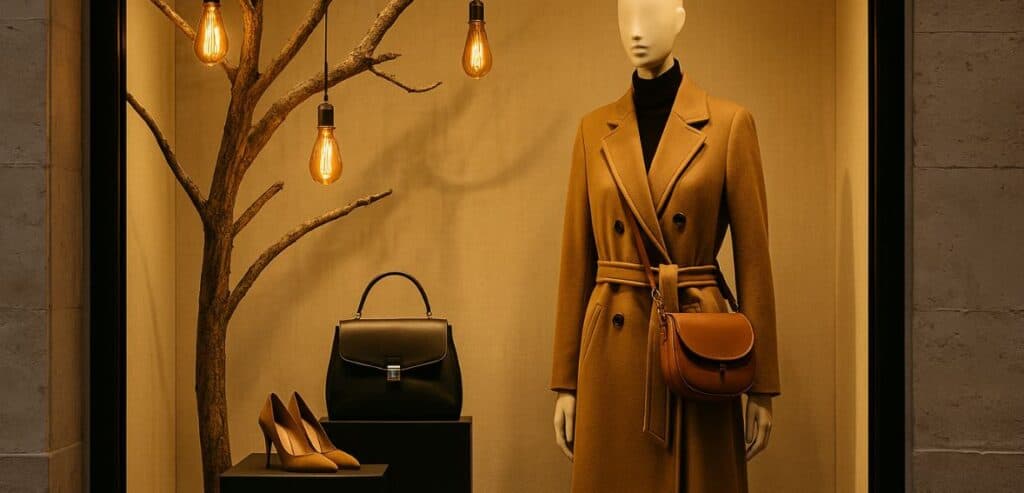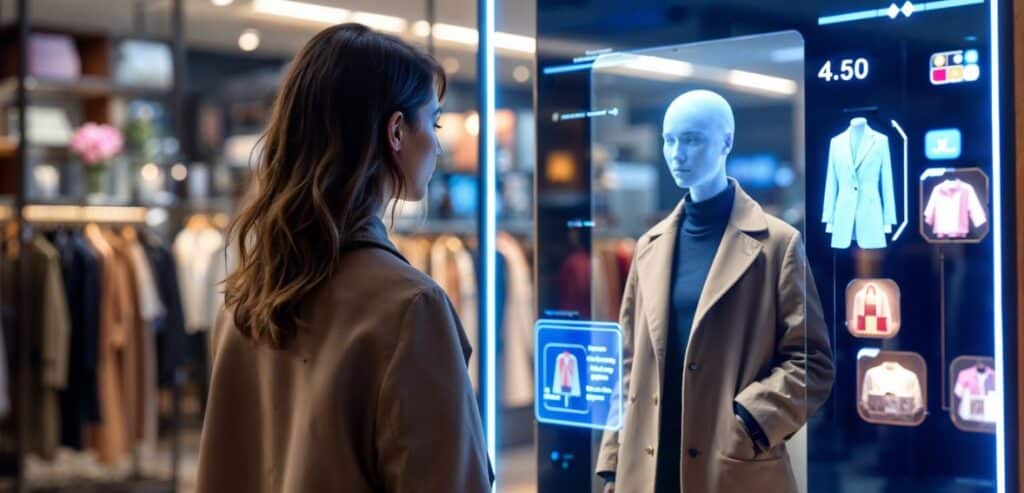
By Jessica Shepherd June 15, 2025
The price tag alone no longer defines luxury in today’s fast-paced, technologically advanced marketplace. Rather, the quality of the experience is becoming a more important metric. Every encounter a customer has, from the time they walk into a store until they make their purchase, adds to their sense of luxury. Physical retail spaces need to change as online retail continues to change how consumers behave.
Luxury stores must now provide sensory-rich, emotionally satisfying experiences that distinguish them from being merely places of commerce. Creating a genuinely opulent in-store experience involves more than just fancy goods or aesthetics; it also involves storytelling, customization, flawless service, and an air of exclusivity. When done correctly, the store transforms into a haven of sophistication and elegance rather than just a showroom. Here is a detailed exploration into how luxury brands and retailers can design in-store experiences that resonate with discerning clientele.
Creating for the Senses: The Influence of Ambience

Above all, luxury is a sensory experience. The physical layout of a store establishes the tone for everything else, from lighting and architecture to sound and smell. Rich textures, warm ambient lighting, minimalist interior design, and calming music create a welcoming atmosphere that makes patrons feel valued and at ease. For example, using signature fragrances fosters emotional bonds in addition to reinforcing brand identity. The layout of the store Is also very important. A space free of clutter promotes slow exploration and showcases the artistry of each piece.
Customers are drawn into carefully chosen displays without feeling overpowered by the environment’s natural flow thanks to thoughtful spatial planning. When each component of the design is deliberate, it conveys the exclusivity and attention to detail that are associated with luxury.
Theater as Service: The Human Touch in a Digital World
The foundation of an opulent experience is still outstanding customer service. Employees need to represent the brand more than just being courteous or informed. Luxury associates are taught to act as brand ambassadors in addition to being salespeople, as evidenced by their speech patterns and clothing choices. They must be able to identify repeat clients by name, comprehend their preferences, and provide discreet advice without being obtrusive.
This high-level service is like a performance—shameful, knowledgeable, and always polished. Employees must foresee needs before they materialize and add value with well-considered recommendations and knowledgeable insights. The human element is what makes the in-store luxury experience so remarkable in a time when digital self-service is becoming the standard.
Customization Beyond the Name Tag
True luxury is about giving the customer a sense of being seen and valued. Personalization has evolved beyond simply addressing someone by name to include customized experiences that show deep understanding. Thanks to advanced customer profiles and CRM systems, retailers can now keep track of preferences, previous purchases, and even preferred shopping times.
For instance, if a returning customer has previously purchased a specific designer or product type, staff can pre-select similar items and create a customized shopping experience. Invitations to exclusive events, personalized product recommendations, or customized packaging all contribute to this improved experience. The goal is to make each visit feel as if it was created especially for that individual.
Telling Tales With Visual Merchandising

Narratives are the lifeblood of luxury brands. Customers are drawn into a brand’s world through storytelling, whether it’s the history of a century-old watchmaker or the imaginative concept behind a limited-edition handbag. These narratives are presented on the stage of visual merchandising. Window displays are now immersive installations that arouse curiosity and emotion rather than being static showcases.
The brand story is allowed to develop naturally within the store through artisan demonstrations, seasonal narratives, and themed sections. The consumer is entering a meticulously curated world that embodies a way of life, a philosophy, and a feeling of community rather than merely shopping.
Combining Elegance and Technology

When used carefully and subtly, technology can elevate rather than diminish the luxury experience. Digital lookbooks, augmented reality mirrors, and tablets for virtual try-ons can all be stylish and convenient. Digital payment methods or self-checkout should be smooth and discrete. Behind the scenes, integrated data systems can facilitate easier returns and exchanges, lower friction in the purchasing process, and track inventory in real time. For the customer, these back-end efficiencies result in a seamless and elegant experience.
For tailored merchant solutions that support luxury retail experiences, learn more.
VIP treatment and exclusive access
A key component of luxury is exclusivity. Providing concierge services, private appointments, and VIP rooms heightens the feeling of privilege. High-value customers who demand a shopping experience free from crowds, noise, and waiting are catered to by these special offers.
Brands can create stronger emotional bonds by offering elite clients first dibs on new collections, invitations to private events, or one-on-one styling sessions. Instead of feeling forced or transactional, these encounters must feel genuine and authentic. When executed properly, they transform upscale shopping into a treasured custom.
Sustainability as a Complexity
Sustainability is not merely an accessory in today’s luxury market; rather, it is a fundamental component of contemporary sophistication. High-end clients are now equally moved by purpose as they are by exclusivity. The environmentally conscious consumer wants to know that their high-end purchase benefits the environment as well. Luxury brands are enhancing prestige rather than undermining it when they adopt eco-friendly practices, such as providing recyclable or reusable packaging and sourcing products responsibly.
However, it goes beyond simply checking sustainability boxes. The subtle yet impactful communication of these efforts throughout the in-store experience is what makes the difference. These small moments, such as a salesperson pointing out the cashmere sweater’s traceable origin or a display card explaining how a bag was tanned using vegetable dyes rather than chemicals, strengthen the emotional bond with the brand.
These ideals can even be seen in the store itself. Scent diffusers that use organic essential oils, LED lighting, and repurposed wood fixtures all tell a story without using loud words. By doing this, the store transforms from a place to purchase goods to one that reflects the values of the customer. Because of this balance—between style and accountability—sustainable luxury is not only acceptable but highly sought-after.
Creating Positive Moments

Shopping for luxury involves more than just making a purchase; it also involves how one feels as soon as they enter. The magic occurs during that emotional change, during that feeling of being transported. And frequently, it’s the small, considerate moments of joy that make an impression rather than the large gestures.
Small gestures like a warm greeting with the customer’s name, a discreet offer of a perfectly timed espresso, or the subtle scent of their favorite beverage permeating the room are the ones that leave a lasting impression. It takes empathy to create that kind of joy. The first step is to pay close attention to what the customer says and doesn’t say. Not only does a great luxury associate help, but they also confidently and intuitively guide without ever making the encounter feel like a transaction.
Together, these small moments create a memory that is both subtly remarkable and intensely personal. People return to the boutique for the atmosphere rather than the merchandise in a world where everything can be found online. The difference between in-store shopping vs online shopping lies not just in convenience, but in the emotional imprint left behind by personal and sensory experiences.
Tempo and Pacing: Letting the Experience Breathe
Experienced at a slow, deliberate pace, true luxury is never hurried. Customers should be able to stay, explore, and take in the atmosphere in-store without feeling rushed. Calm is facilitated by thoughtfully positioned seating, soft transitions between displays, and leisurely service. The emotional resonance of the visit is increased by staff members who naturally follow the customer’s rhythm, understanding when to interact and when to back off.
By developing intimacy and introspection, these silent moments turn a store from a place of commerce into a haven. The sensation of slowing down turns into a luxury in and of itself in this era of perpetual acceleration; it is an engaging of time, presence, and mindfulness that strengthens brand connection.
Staff Empowerment and Training
Without the proper team, no luxury strategy can be successful. Employees should receive ongoing training in emotional intelligence, cultural sensitivity, and hospitality etiquette in addition to product knowledge. Employees who feel empowered are more self-assured, more receptive, and better able to adjust to the needs of each individual customer.
Frontline employees should be encouraged to exercise judgment, form genuine connections, and take initiative in a culture that managers cultivate. When employees feel appreciated, they will value their clients as well, starting a positive feedback loop.
Retail as Hospitality Reimagined
Luxury retailers need to think like hoteliers if they want to genuinely improve the in-store experience. Every customer is treated like a guest, the salesperson transforms into a host, and the store becomes an opulent lounge. With this mentality, relationship-building becomes more important than sales metrics. Immersion is what luxury buyers seek, not speed. Brands can slow down the retail experience by adopting a hospitality-first strategy, which enables customers to enjoy the moment, ask questions, and feel cared for rather than marketed to.
Activating the Senses and Emotions: The Psychological Foundation of Luxury
In luxury retail, opulence is defined by the emotional and sensory experience the store provides, not just by the price tag. It all comes down to perception. Customers are entering a place that should represent their identity, goals, and status when they enter a high-end boutique, not just to shop.
The sensory environment is where that connection starts. Often, distinctive smells cling to the air, gently connecting location to memory. Warm, purposeful lighting brings out the richness of materials and enhances textures. The background is filled with carefully chosen, subdued music that never overpowers but always enhances. These intricate details subtly convey exclusivity and enhance the whole encounter.
However, design is insufficient on its own. Employees should be perceptive hosts who pay close attention, read cues, and offer assistance without pressuring. A visit can become a relationship if previous preferences are remembered or genuine suggestions are made. Storytelling is also very important. People want to bring home more than just a product; they want a narrative that reflects their values, whether it’s the craftsmanship of a limited-edition bag or the legacy of a custom tailor.
Micro-Tips for Elevating In-Store Luxury
Even the most refined retail strategy benefits from a few tactical touchpoints. The following improvements are modest but effective:
- Adjust the temperature according to the season, making it warm and comfortable in the winter and cool and crisp in the summer.
- Depending on the length of the customer’s visit, provide discreet refreshments.
- Using scent zoning to direct emotional flow in various store sections.
- Staff members receive instruction on mirror etiquette so they are aware of when and how to approach.
- Provide clutter-free tactile stations where patrons can feel materials.
- Create “pause spots” with tasteful furniture or artwork that invites people to stay.
The accumulation of these little luxuries creates an atmosphere that is not only pricey but also truly unique.
Conclusion: Experience is the New Luxury
The definition of luxury is expanding. In a world where products are more accessible than ever before, the in-store experience is what differentiates true luxury from the merely expensive. Atmosphere, personalization, human connection, and emotional resonance have become the hallmarks of modern retail success.
Creating an in-store experience that feels truly luxurious requires alignment between space, people, technology, and brand story. It demands attention to detail, cultural sensitivity, and a customer-centric mindset. When these elements harmonize, they transform the act of shopping into an unforgettable journey—one where the customer doesn’t just purchase a product but becomes part of a story worth telling.
In this new era of experiential luxury, it is no longer enough to sell opulence. Brands must deliver meaning, emotion, and beauty at every touchpoint. Because in the end, the most luxurious thing a store can offer is not a product, but a feeling.